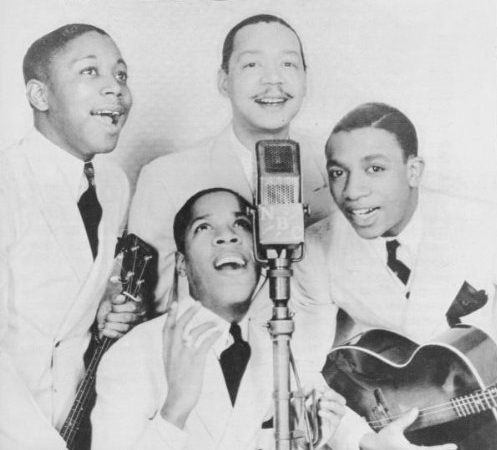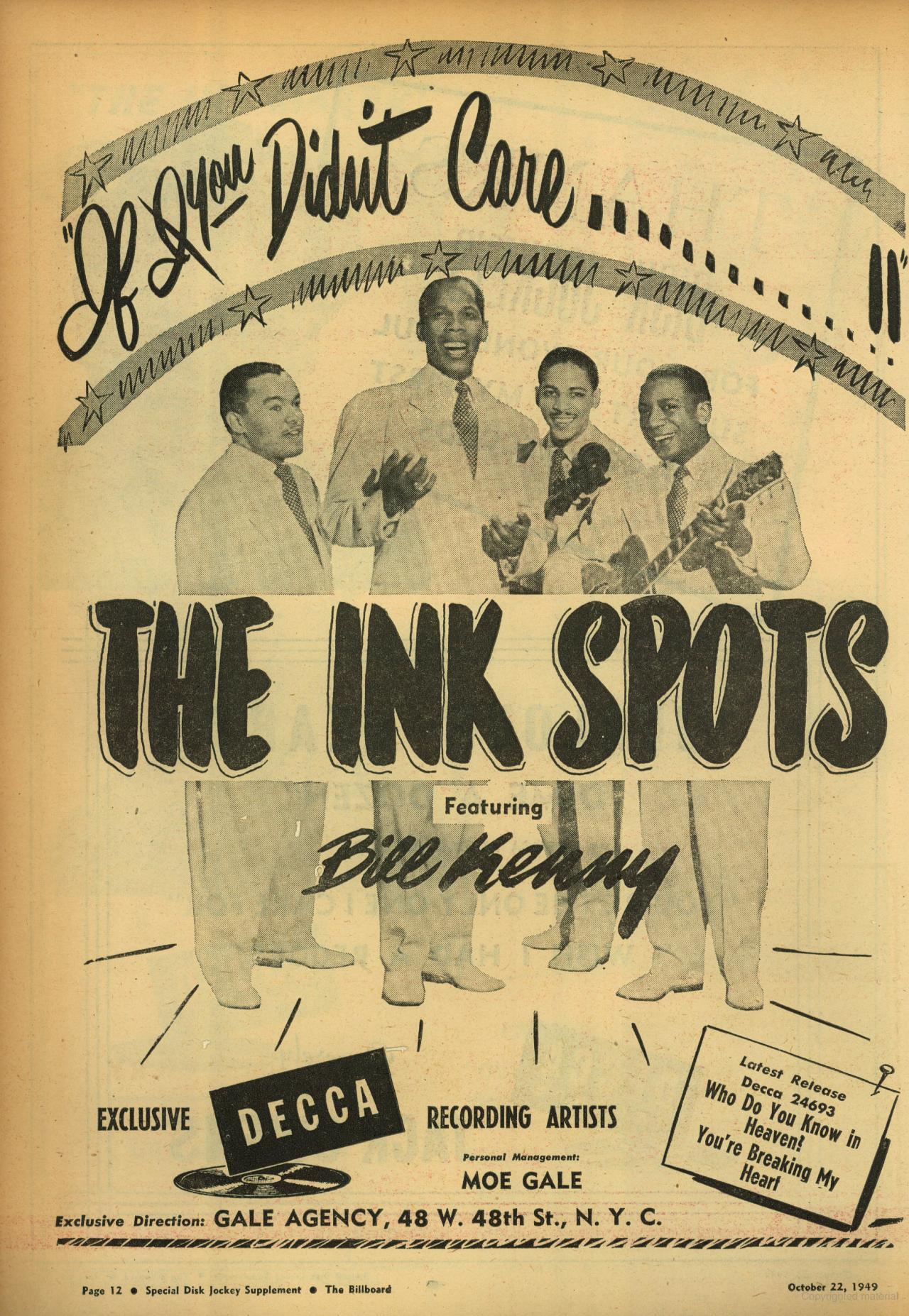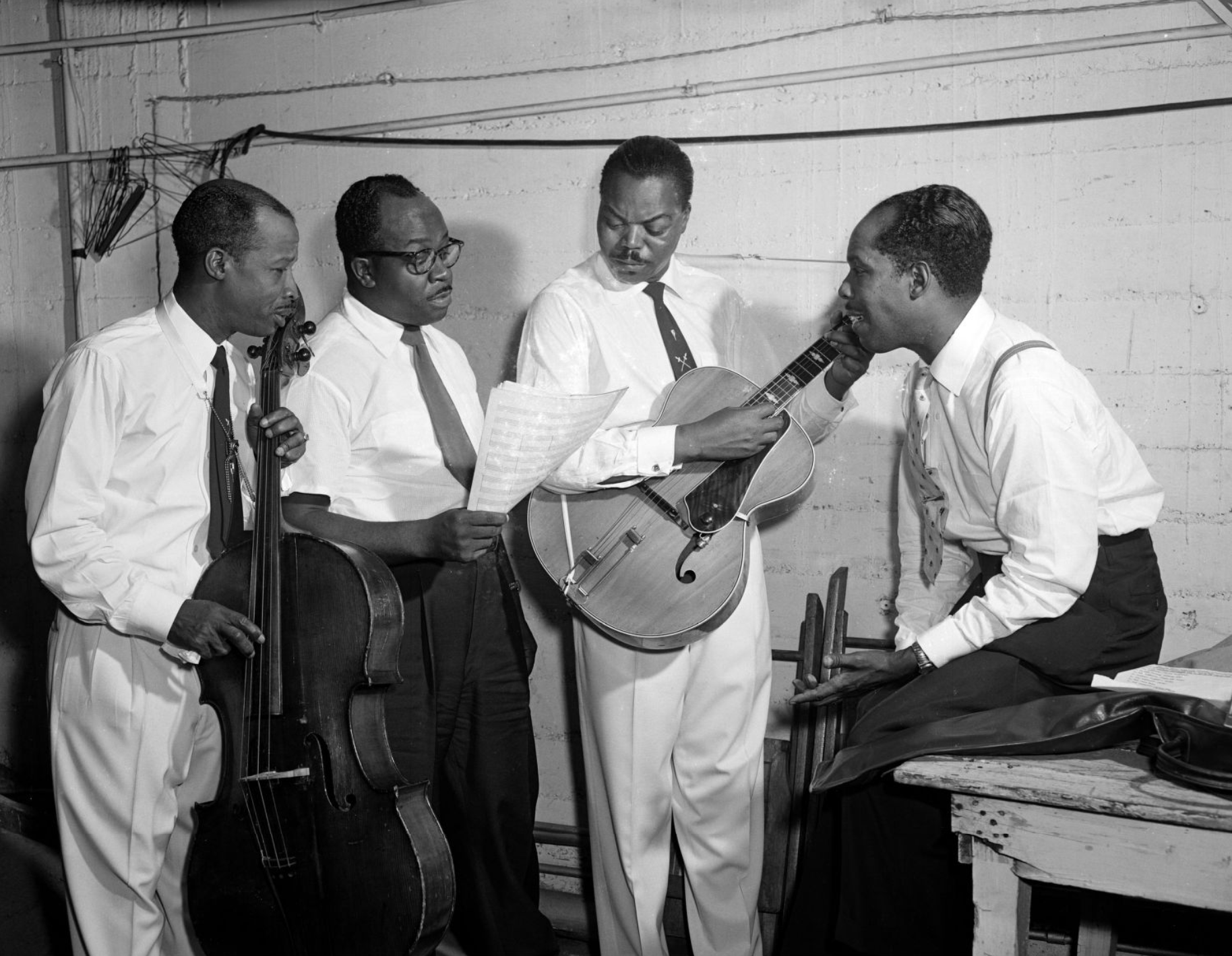The popular African American vocal group The Ink Spots got their start in Indianapolis in 1928. Original members included Orville “Hoppy” Jones, Ivory “Deek” Watson, Charlie Fuqua, and Jerry Daniels. Daniels and Fuqua had performed as Kyle and Charlie, while Jones and Watson had performed in a quartet called the Four Riff Brothers. and influenced the music of these earlier acts. When the Four Riff Brothers disbanded after 1931, Daniels, Fuqua, Jones, and Watson united to form King, Jack, and Jester before finally settling on calling themselves The Ink Spots after a legal conflict with another vocal group that already called themselves the King’s Jesters.

Indianapolis radio station , along with Cleveland’s WHK and Cincinnati’s WLA, gave the group considerable Midwestern exposure via live radio appearances. Moving to New York City, they appeared as the Four Ink Spots at Harlem’s Apollo Theatre on August 3, 1934. RCA Victor Records signed The Ink Spots in 1935, which led to the start of a European tour.
None of the six recordings The Ink Spots made for RCA Victor hit the charts. Released from their record label, Decca Records signed the group and replaced singer Jerry Daniels with Bill Kenny, a former football star, in 1936. Kenny’s versatile vocals attracted Black and white audiences. He introduced a new singing style called “Top to Bottom,” which featured his high tenor carrying the melody followed by bass singer Hoppy Jones speaking the words of the song in a low reflective voice. Part of the Ink Spots’ style also involved improvising vocal harmonies by simulating wind instruments with their voices.

The Ink Spots’ signature style featured prominently in their 1939 breakthrough song “If I Didn’t Care,” which became its biggest hit selling over 19 million copies. In 2023, it remained the eighth best-selling single of all time. From 1940 through 1949, the group had 30 hits. One included a collaboration with legendary jazz singer Ella Fitzgerald. This recording reached the number-one spot on the U.S. Billboard pop charts in 1944.
By the late 1940s, however, The Ink Spots faced both musical and personal problems. Billboard Magazine described their formerly fresh musical style as “old-fashioned.” Illnesses, internal conflicts, and legal battles affected the group’s line-up. In 1943, the U.S. Army drafted Fuqua to participate in World War II. Numerous musicians filled in for him until his return to the band in March 1945. Hoppy Jones died in October 1944. At least four musicians served as replacements for Jones.
Despite the turbulent situation, The Ink Spots continued to gain widespread popularity among both Black and white audiences through the post-war years. The group broke down racial barriers by appearing in previously all-white Southern venues. In 1948, they performed at Miami’s Monte Carlo Club, headlining over several white acts. Billboard Magazine reported that the format signaled a radical departure for a Southern state. No club operators in the Deep South previously had headlined an all-Black group.
Kenny assumed leadership of the group in 1951. A year later, Fuqua left, leading to a legal battle over the use of The Ink Spots name. A court decided Kenny’s group could continue to record and tour as The Ink Spots, while Fuqua could use a new name—Charlie Fuqua’s New Ink Spots.

Fuqua’s departure led to more line-up changes for Kenny’s version of The Ink Spots. The instability of a permanent line-up finally forced Kenny to disband The Ink Spots officially in July 1954.
Over the years that followed countless vocal groups modeled themselves after The Ink Spots. Scores of others performed and recorded under the name, using the original Ink Spots’ trademark romantic, bluesy ballads sung in perfect harmony. With a high-flying tenor floating above their tight harmonies, The Ink Spots laid the template from which doo-wop, a style of pop music using close harmony vocals and nonsense phrases, evolved.
The Ink Spots also are considered the forerunners of rhythm and blues and group-style singing, which grew out of African American gospel, jazz, folk, and traditional blues music traditions in the 1940s. Bill Millar, a pioneering author on Black vocal groups, declared that The Ink Spots more “than any other group of the era initiated a stream of development, which led in turn to the Ravens, the Orioles, the Dominoes and the Drifters,” all important, early rhythm and blues groups established right after World War II. Clyde McPhatter, former lead singer of both the Dominoes and the Drifters confirmed in 1969, “We patterned ourselves after the Ink Spots.” These early performers of rhythm and blues took inspiration from The Ink Spots’ sound and moved the genre forward with innovative musical and vocal twists. In his book The Drifters (1971), Millar further stated that The Ink Spots’ patterns of vocal harmony “established, if not introduced, what was to become a standard pattern for the majority of Black vocal quartets.”
Ink Spots, Best of the Ink Spots – 2 LP (1939-50)
Credit: Internet Archive
The Ink Spots were inducted into the Grammy Hall of Fame in 1987, the Rock and Roll Hall of Fame in 1989, and the Vocal Group Hall of Fame in 1997. A total of 20 different people performed as members of the group throughout the band’s 26-year history. Despite this instability, the Ink Spots managed to top the charts 86 times, with 16 songs selling no fewer than 1 million copies.
In 2015, musician and record label owner Jack White purchased Elvis Presley’s first acetate recordings from 1953 at an auction at Presley’s former home Graceland. These recordings included the songs “My Happiness” and “That’s When Your Heartaches Begin,” the latter of which The Ink Spots popularized in 1941. Presley’s rendition of this song offers proof of The Ink Spots’ influence on Rock n’ Roll.
The group’s songs have been used in countless films and television shows. Martin Scorsese used several songs in the 1980 film Raging Bull and his 2004 film The Aviator. The HBO hit Better Call Saul used The Ink Spots’ music in multiple episodes during the show’s run from 2015 to 2022.

Help improve this entry
Contribute information, offer corrections, suggest images.
You can also recommend new entries related to this topic.




